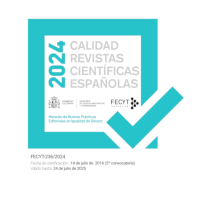3D printing as an educational resource to develop mathematical talent
DOI:
https://doi.org/10.18172/con.4999Keywords:
Math clubs, educational 3D printing, math talentAbstract
This article contains the experiences in the use of 3D printing in a math club at Madrid which took place between 2017 and 2019. After the analysis of students’ productions we distinguish four types of projects that can be included in a math classroom using a 3D printer that encouraged collaborative work.Downloads
References
Berry, R. Q., Bull, G., Browning, C., Thomas, C. D., Starkweather, G. y Aylor, J. (2010). Use of digital fabrication to incorporate engineering design principles in elementary mathematics education. Contemporary Issues Technology and Teacher Education, 10(2), 167-172.
Callejo de la Vega, M. L. (2010). Un club matemático para la diversidad. Narcea Ediciones.
Canessa, Ch. E., Fonda, C. y Zennaro, M. (Eds.) (2013). Low-Cost 3D Printing for Science, Education and Sustainable Development. ICTP Science Dissemination Unit.
Department of Education (2013). 3D printers in schools: uses in the curriculum. Research and Analysis, October 2013, Gov.UK. https://www.gov.uk/government/publications/3d-printers-in-schools-uses-in-the-curriculum
Ford, S. y Minshall, T. (2018). Where and how 3D printing is used in teaching and education. Additive manufacturing, 25, 131-150. https://doi.org/10.1016/j.addma.2018.10.028
Hart, G. W. (2005). Creating a mathematical museum on your desk. The Mathematical Intelligencer, 27, 14-17. https://doi.org/10.1007/BF02985853
Huleihil, M. (2017). 3D printing technology as innovative tool for math and geometry teaching applications. IOP Conf. Ser.: Mater. Sci. Eng., 164(1), 012023. http://doi.org/10.1088/1757-899X/164/1/012023
Karp, K. S. y Niemi, R. C. (2000). The math club for girls and other problem solvers. Mathematics Teaching in the Middle School, 5(7), 426-432.
Madonna, C. y Park, S.S. (2017). Como organizar un club de Matemática. Lulu.
Morante, A. y Vallejo, J. A. (2011). Modelling the landing of a plane in a calculus lab. International Journal of Mathematical Education in Science and Technology, 43(7), 936-949. https://doi.org/10.1080/0020739X.2011.633626
Niss, M. (2003). Mathematical competencies and the learning of mathematics: the Danish Kom Project. Roskilde University.
Papanastasiou, E. C. y Bottiger, L. (2004). Math clubs and their potentials: Making mathematics fun and exciting. A case study of a math club. International Journal of Mathematical Education in Science and Technology, 35(2), 159-171. https://doi.org/10.1080/00207390310001638395
Prescott, A. E. y Pressick-Kilborn, K. J. (2015). It's great to be doing maths! Engaging primary students in a lunchtime club. Australian Primary Mathematics Classroom, 20(3), 34-49.
Rainone, M. Fonda, C. y Canessa, E. (2014). IMAGINARY Math Exhibition Using Low-cost 3D Printers. ArXiv, abs/1409.5595.
Segerman, H. (2016). Visualizing Mathematics with 3D Printing. Johns Hopkins University Press.
Singer, F. M., Sheffield, L. J., Freiman, V. y Brandl, M. (2016). Research On and Activities For Mathematically Gifted Students. Springer Nature.
Singer F. M. (2018). Enhancing Creative Capacities in Mathematically-Promising Students. Challenges and Limits. En F. Singer (Ed.), Mathematical Creativity and Mathematical Giftedness (pp. 1-23). ICME-13 Monographs. Springer, Cham. https://doi.org/10.1007/978-3-319-73156-8_1
Stansell, A. y Tyler-Wood, T. (2016). Digital fabrication for STEM projects: a middle school example. IEEE 16th International Conference Advance Learning Technologies (ICALT), 483-485. https://doi.org/10.1109/ICALT.2016.44
Sun, Y. y Li, Q. (2017). The application of 3D printing in mathematics education. 12th International Conference on Computer Science and Education (ICCSE), 47-50. https://doi.org/10.1109/ICCSE.2017.8085461
Downloads
Published
How to Cite
Issue
Section
License
The authors retain copyright of articles and authorize Contextos Educativos. Revista de Educación the first publication. They are free to share and redistribute the article without obtaining permission from the publisher as long as they give appropriate credit to the editor and the journal.
Self-archiving is allowed too. In fact, it is recommendable to deposit a PDF version of the paper in academic and/or institutional repositories.












